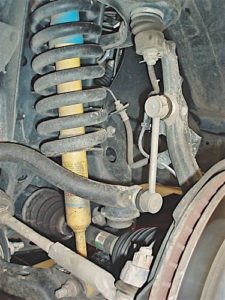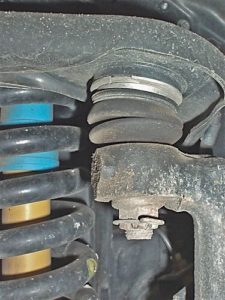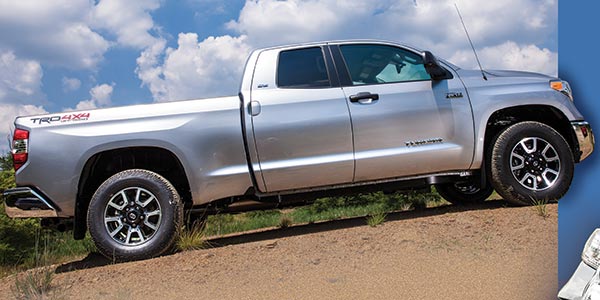Click here to read Part 1 of this story.
TIRE WIDTH AND SAI
As noted in the December 2016 Diagnostic Solutions article, a line drawn through the upper and lower ball joints (the steering axis inclination or SAI angle) should intersect the road surface with the center tread bar of the tire, which provides an exact pivot point for steering the front wheel. This SAI pivot point reduces steering effort and road shock at the steering wheel.
Unfortunately, extra-wide tires often require offset wheel rims to allow a full turning radius inside the wheel well. Any amount of wheel offset places the center tread bar well outside the pivot point established by SAI, which often causes steering wander complaints when driving over uneven paved surfaces. See Photo 4.

Instead of loading the ball joints directly through the center tread bar, offset wheels load the ball joints to the inside of the center tread bar. Looking from the front of the vehicle, the spindle and suspension parts are loaded in a clockwise pattern on the left side and a counterclockwise pattern on the right. The farther the tire is moved outward on the spindle, the greater the stress on the ball joints and control arm bushings. Increased steering effort is another phenomenon that occurs when the center tread bar is located outside of the SAI pivot point. Instead of pivoting, the steering system must “drag” the tire around the pivot point, which is why offset wheels increase steering effort and wear on the steering linkage.
TIRE DIAMETER ISSUES
Large differences in tire circumference or “stagger” can adversely affect ABS braking, which in turn can affect vehicle stability control (VSC). In general, differences in tire circumference as measured with a tape measure shouldn’t exceed 0.5 inches. Although the casing size might be the same, tire circumference can vary greatly due to differences in tread wear rates, especially among tires with deep, aggressive treads, which is why I recommend frequent tire rotations on 4WD and AWD vehicles. Additional complaints can be caused by larger tire circumferences that reduce braking power.

SUSPENSION HEIGHT
Our 2014 Toyota Tundra is equipped with a short- and long-arm front suspension system coupled with rack-and-pinion steering, both of which can be sensitive to suspension height (see Photo 5). To determine correct front suspension height, Toyota measures the difference between the front lower control arm cam bolt center (“A”) and the center of the front wheel or spindle (“B”) to the ground with the vehicle unloaded. The distance depends upon truck model and tire size and is generally within a two-inch range.
At the rear axle, the difference is measured between the front leaf spring pivot (“C”) and the axle shaft center (“D”) to the ground. Here again, specifications depend upon vehicle model and tire size. That said, any changes in suspension height would affect front suspension geometry, which in turn affects the truck’s dynamic wheel alignment and steering quality.
Getting the Rest of the Story…
Comebacks are expensive, not only in terms of time and money lost, but also in terms of customer satisfaction. In many cases, we’re setting ourselves up for failure whenever we write up a customer request for a wheel alignment without getting what radio commentator Paul Harvey used to call, “The Rest of the Story.” Getting the rest of the story involves asking why the customer believes he needs a wheel alignment. In general, customer wheel alignment complaints fall into three basic categories: tire wear, steering quality and road vibration.
Towing heavy campers, boats or trailers during the weekends can cause tire wear complaints. In these cases, the wheels might be perfectly aligned when the truck comes into the shop, but not be aligned when the vehicle is driven long distances with heavy loads. The solution might not be still another wheel alignment, but rather a pair of air bags or air-assisted shock absorbers installed on the rear axle to compensate for temporary heavy loads.
Loading heavy camping equipment into the bed of a light-duty pickup truck can cause steering quality complaints. Any recreational truck should be equipped with OE-specification heavy-duty tires, suspension and ride control equipment. Remember, too, that crosswinds adversely affect steering quality when hauling campers or towing recreational trailers. In these instances, inadequate tire ratings and weak suspension systems are at fault.
Lastly, don’t forget that vibration complaints on rough-trail or off-road vehicles are most often caused by mud collecting inside the wheels or by the driveshaft contacting large rocks. In rare cases, a tire can be ruined or a wheel can be bent from severe rough-road driving.














